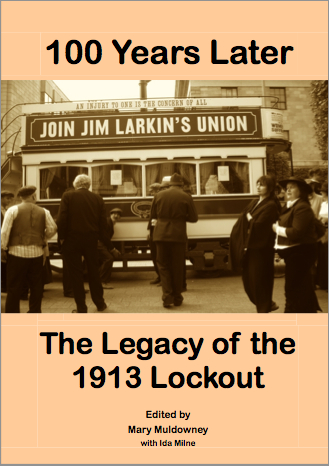Over 30 years of anarchist writing from Ireland listed under hundreds of topics
Review: 100 Years Later: The Legacy of the 1913 Lockout.
Date: Mon, 2014-06-30 21:25
 History has traditionally been viewed through the prism of ‘great leaders’ or ‘powerful men’ (and it usually is men). In recent years, however, the importance of community or local history – and the contributions of ‘ordinary’ people to great events – has been recognised. To paraphrase Jim Larkin “The great leaders only appear great because of the commitment, sacrifice and energy of ordinary people”.
History has traditionally been viewed through the prism of ‘great leaders’ or ‘powerful men’ (and it usually is men). In recent years, however, the importance of community or local history – and the contributions of ‘ordinary’ people to great events – has been recognised. To paraphrase Jim Larkin “The great leaders only appear great because of the commitment, sacrifice and energy of ordinary people”.
“100 Years Later – The Legacy of the 1913 Lockout”, edited by Mary Muldowney and Ida Milne and published by Seven Towers, is a strong and powerful contribution to shining a light on the “hardship and heroism that was part of that epic struggle.”
Bravery and sacrifice
In her introduction to the book Mary Muldowney writes “The many achievements in employment rights that were a feature of the twentieth century are a constant reminder of the bravery and the sacrifices of members of the labour movement in the 100 years since the Lockout that have consistently inspired and encouraged those who came after them. In 2013 we owe it to ourselves and our children to recognise the legacy and to keep that spirit of 1913 in our hearts as we tackle the considerable challenges that face us.”
This book consists of a series of articles based on interviews carried out by the 1913 Alternative Visions Oral History group – who came together in September 2012 with the objective of learning the skills, techniques and ethical issues involved in collecting oral histories. In this they succeeded brilliantly and between them the contributors to this book have brought together a real sense that the Lockout was a time of great turmoil, trouble, sacrifice and excitement – and one that has left a lasting legacy, not just in terms of the bigger political and trade union picture but also in terms of family and community memory.
Memories and legacy
The book doesn’t just look at memories of 1913 – although it does that. It also explores its legacy and its effect on subsequent decades of trade unionism and trade union battles. Nowhere is this more obvious than in Chapter 8 in which Joe Mooney and Sarah Lundberg interview members of the Dublin Dockland community about their family memories and stories of the Lockout.
“The Lockout might have officially ended in January 1914,” they write, “but for many there was no ceasefire. This was a conflict that would send echoes down through the years, and carry with it the mottos, lessons and antagonisms that would become part of a way of life.”
Everybody who knows anything about the 1913 Lockout will have heard of James Nolan – one of the martyrs of the time, having been batoned to death by 5 policemen on 30th August 1913, just 4 days into the Lockout. Alan Mac Simóin’s contribution (Chapter 3) brings the story of Nolan’s death, its impact on his community, and its lasting legacy in terms of his family’s memory to life through an interview with Moira Crawford, whose great grandmother was a sister of Nolan’s wife.
“The family thought that James [Nolan] basically was a victim and a hero so they didn’t have any, what would you say – they had no dispute with James Larkin. They fought, the way they fought, you know they were so hurt and basically for us. We were the ones who benefit from all the work they did at the time.”
These are just a couple of examples of the many family and community memories that pepper the book.
Renewed commitment
The 1913 commemorations saw copious amounts of hypocrisy, with trade union leaders and politicians who today preach compromise and capitulation lauding the heroic stance taken by workers 100 years ago. But the commemorations also saw real and genuine remembrances of those struggles and a renewed commitment by many to take the lessons of those struggles and apply them to the problems facing us today.
This book falls very much into the latter category. It’s a refreshing read, it brings memories of 100 years ago to life and its honesty and ease of access recommends it to all – whether you think you know everything there is to know about the time or whether you know very little about it.
The approach used and the style of presentation leaves this reader looking forward to this group of writers and publishers’ exploration of other topics to do with our labour and folk history.
“100 Years Later: The Legacy of the 1913 Lockout”, edited by Mary Muldowney and Ida Milne
Available from seventowers.ie €12.99


